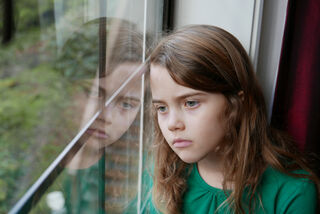Depression
Is My Child Depressed or Just Feeling Down?
Can a child really be depressed? Yes, especially during a pandemic.
Posted December 31, 2020

It's estimated that the pandemic has affected more than 860 million children worldwide. Mental health has been every parent's concern for the past 10 months, and rightfully so. It's become increasingly difficult for all caregivers to discern serious mental health issues from coping with the daily struggle of isolation, grief, loneliness, and uncertainty. "Is my child just grieving the loss of their pre-COVID lifestyle, or are they depressed?" has sadly become a common question posed to mental and medical health professionals.
Unfortunately, even before COVID-19, depression was one of the most common mental health conditions to wreak havoc on children's lives. Studies on the global prevalence of depression in children before COVID-19 were estimated to be 2.8 percent in young children (under 13). You can imagine how life in lockdown changed those statistics.
A survey conducted in China, distributed to children aged 7-18, found that 22 percent of respondents were suffering from depressive symptoms. Similarly, Italy and Spain, two of the countries most affected by COVID-19, surveyed 1,143 parents of children aged 3-18. The results were heartbreaking. Almost 86 percent of the parents perceived changes in their children's emotions and behaviors during the quarantine. The most commonly reported symptoms were difficulty concentrating (76.6 percent), irritability (39 percent), restlessness (38.8 percent), nervousness (38 percent), feelings of loneliness (31.3 percent), uneasiness (30.4 percent), and worries (30.1 percent). Sadly, most of these symptoms are clinical "red flags" for the beginnings of depression.
Signs and symptoms
It's imperative that transient sadness not be pathologized. Sadness is a normal, universal human emotion and reaction to loss, disappointment, and perceived disadvantage. However, there is a difference between temporary sadness and sadness that seems to persist.
If you notice that your child seems to be "stuck" in a sad state, it may be time to consider seeking out the aid of a pediatrician or mental health professional. It's also important to address and eradicate stigma and misinformation around childhood depression. Many adults have been misled to believe that it is not possible for children to become depressed. This is a serious inaccuracy, leaving many struggling children untreated and at risk for worsening symptoms or even suicide.
The CDC outlines the following behaviors and symptoms often seen in children with depressive symptoms:
- Feeling sad, hopeless, or irritable a lot of the time
- Not wanting to do or not enjoying doing fun things
- Showing changes in eating patterns—eating a lot more or a lot less than usual
- Showing changes in sleep patterns—sleeping a lot more or a lot less than normal
- Showing changes in energy—being tired and sluggish or tense and restless a lot of the time
- Having a hard time paying attention
- Feeling worthless, useless, or guilty
- Showing self-injury and self-destructive behavior
Additionally, the Anxiety and Depression Association of America states that childhood depressive symptoms differ from those of adults, reporting irritability and anger as more frequently cited symptoms. Furthermore, children are more likely to make somatic or bodily complaints when depressed, such as aches, pains, and restlessness. For example, frequent complaints, like "My tummy aches" or "My head hurts," are cause for further investigation.
Tips for parents
1. Don't wait to get help. Depression is treatable.
Passing off depressive symptoms as a "phase" or part of normal childhood development can lead to serious consequences. It's always wise to err on the side of caution and have your child evaluated if uncertain or unsure of a potential mental health condition.
2. Talk to your child about their feelings.
Providing a safe, nonjudgmental environment for your child to discuss their feelings can help provide clarity and insight into their mental state and inner world. Keep in mind that younger children may not have the emotional understanding or lexicon to describe their feelings. Emotion charts have proven to be a helpful aid for this tough conversation.
3. Monitor your child's moods.
Thankfully, technology has made this task easier. There are a plethora of apps available to track and graph daily emotions. Some will even alert you to the possibility of a mood disorder or encourage an individual to seek professional assistance.
If your child or someone else you know is having thoughts of suicide, contact the National Suicide Prevention Lifeline at 1-800-273-TALK (1-800-273-8255). If you or a loved one are in immediate danger, call 911. Visit Psychology Today's Therapist Directory to find a mental health professional near you.


